

The information available on this page will also give examples of how you can use the concepts of reinforcement and punishment to influence the behaviour of your teenage children as part of your parenting. Operant Conditioning (B.F. Skinner) How Reinforcement and Punishment Modify Behavior Operant conditioning, also known as instrumental conditioning, is a method of learning normally attributed to B.F.
Skinner, where the consequences of a response determine the probability of it being repeated. Operant Conditioning. Operant conditioning. Classical Conditioning - Ivan Pavlov. The difference between classical and operant conditioning - Peggy Andover. In Summary. Positive Reinforcement and Operant Conditioning. In operant conditioning, positive reinforcement involves the addition of a reinforcing stimulus following a behavior that makes it more likely that the behavior will occur again in the future.

When a favorable outcome, event, or reward occurs after an action, that particular response or behavior will be strengthened. One of the easiest ways to remember positive reinforcement is to think of it as something being added. By thinking of it in these terms, you may find it easier to identify real-world examples of positive reinforcement. Using Positive Reinforcement to Improve Behavior. When your child misbehaves, rewards might be the last thing on your mind.
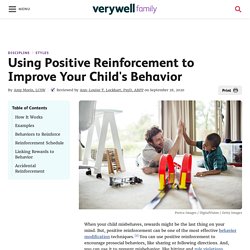
But, positive reinforcement can be one of the most effective behavior modification techniques.1 You can use positive reinforcement to encourage prosocial behaviors, like sharing or following directions. And, you can use it to prevent misbehavior, like hitting and rule violations. Positive reinforcement can also be an effective way to encourage and motivate your child to be responsible, do their chores, get along with their siblings, or complete their homework assignments without arguing.
Using Positive Reinforcement With Young Children. Positive Reinforcement for Adolescents. By the time children have reached adolescence, their responses are often ingrained, but parental actions can still positively affect adolescent behavior. Since adolescents are struggling to develop their personal identity and are concerned about their body image, parental support is crucial to help positively frame experiences as learning opportunities.
Positive reinforcement remains a powerful teaching tool during these formative years, and we encourage parents to take time to contemplate the ways they can help adolescents mature and become self-reliant. Reinforce mature decisions by allowing increased privileges when adolescent demonstrates increased responsibility. How to Reward Your Teen for Good Behavior. Teenagers are young adults who are trying to learn the ways of the world.
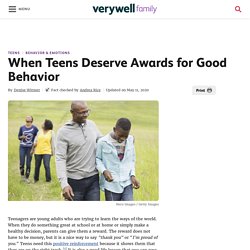
When they do something great at school or at home or simply make a healthy decision, parents can give them a reward. The reward does not have to be money, but it is a nice way to say "thank you" or "I'm proud of you. " Teens need this positive reinforcement because it shows them that they are on the right track.1 It is also a good life lesson that you can pass on: good things happen to good people. When Do Teenagers Deserve a Reward? A teen can earn a reward for positive behavior or by changing negative behavior.1 While you should not feel that you have to "pay" for every good thing your teen does, reinforcement of good behavior will help ensure that it continues. Negative Reinforcement: What Is It and How Does It Work?
What is negative reinforcement?
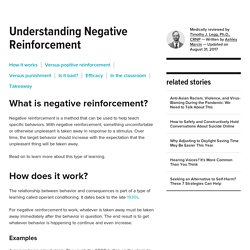
Negative reinforcement is a method that can be used to help teach specific behaviors. With negative reinforcement, something uncomfortable or otherwise unpleasant is taken away in response to a stimulus. Over time, the target behavior should increase with the expectation that the unpleasant thing will be taken away. Read on to learn more about this type of learning. USING NEGATIVE REINFORCEMENT TO INCREASE SELF-FEEDING IN A CHILD WITH FOOD SELECTIVITY.
Examples of using Negative Reinforcement on Teenagers. How Reinforcement Schedules Work. Operant conditioning is a learning process in which new behaviors are acquired and modified through their association with consequences.
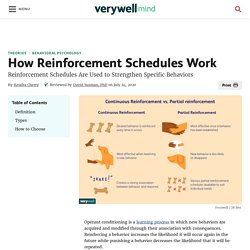
Reinforcing a behavior increases the likelihood it will occur again in the future while punishing a behavior decreases the likelihood that it will be repeated. In operant conditioning, schedules of reinforcement are an important component of the learning process. When and how often we reinforce a behavior can have a dramatic impact on the strength and rate of the response.
Operant Conditioning Schedule of Reinforcement Explained! Schedules of Reinforcement: When to use positive and negative reinforcement – Parenting With Psychology. I’m back at my keyboard after a few weeks’ hiatus during which I spent all my free time landscaping.
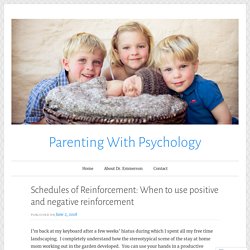
I completely understand how the stereotypical scene of the stay at home mom working out in the garden developed. You can use your hands in a productive manner, making progress rather than just cleaning up and fixing things. There are small, well-defined projects that can be accomplished and checked off your list rather than the ongoing and endless refinement of child rearing. And perhaps the most appealing feature of gardening is that your plants cannot talk, whine, yell, etc. Back to the topic at hand, we’ve already had an introduction to operant conditioning (see Understanding Reinforcement vs. Types of Punishments. Positive Punishment and Operant Conditioning.
Positive punishment is a concept used in B.F.

Skinner's theory of operant conditioning. How exactly does the positive punishment process work? The goal of any type of punishment is to decrease the behavior that it follows. Examples of using Positive Punishment on Teenagers. How Negative Punishment Works. Negative punishment is an important concept in B.
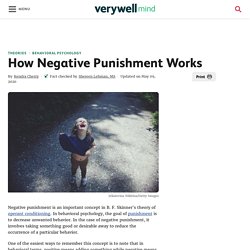
F. Skinner's theory of operant conditioning. Examples of using Negative Punishment on Teenagers. Effective discipline for children. Punishing a child is effective if done correctly. Summary of Effective Punishments: Summary of Reinforcements and Punishments. Physical punishment of children by US parents: moving beyond debate to promote children’s health and well-being. The purpose of the current paper is to offer explanations as to why, in the face of worldwide movement to protect children from violence, physical punishment against children remains normative in much of the world.
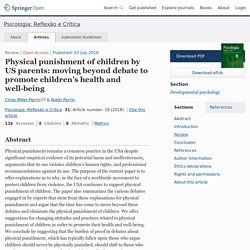
We focus on the USA because the use of physical punishment by parents is very common in the USA, but many of the issues we highlight are relevant to other countries. We also summarize the various debates about physical punishment and argue that the time has come to move beyond these debates to eliminate the physical punishment of children. We offer suggestions for changing attitudes and practices related to physical punishment of children in order to promote their health and well-being.
Support for physical punishment in the USA.